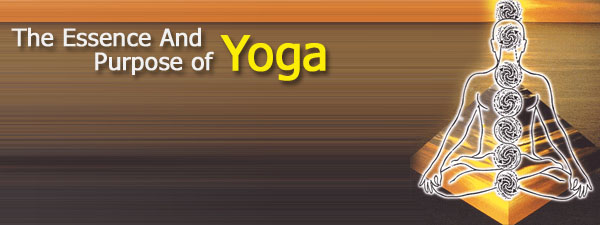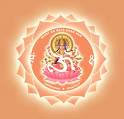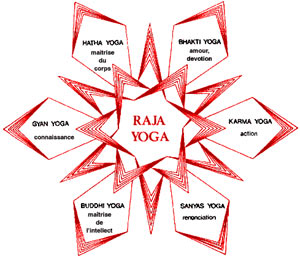
|
Raja Yoga aims at dissolving the modifications of the mind. Patanjali's Yoga Sutra indicates various practical ways to achieve detachment: Surrender to Isvara, viveka, vairagya and the eight angas (means). Surrender to Isvara happens when the desire for things is transformed
into love of the divine. The potent energy- love-aspiration ladder
that is normally directed towards the external world is turned towards
the transcendent Isvara. Viveka (intuitive discernment) helps us to realise that the relative
and dual is not the ultimate reality. This leads to vairagya, a
consciential detachment, not just formal detachment. It is a conscious
self-mastery that Viveka is the fruit of knowledg (jnana) or gnosis, which is capable of revealing the ultimate and real nature of things. Viveka and Vairagya are the two techniques of Vedanta-darsana. Mind Takes Precedence: Raja Yoga emphasises on the mind rather than the body or the emotions.
It seeks to control chitta(right side),the mental substance, with
all its product; The vri6sor thought waves which, if not controlled,
lead the jiva
This sadhana begins with purification of the emotions and of the mind. Without this preliminary clearing of undesirable psychic contents, this type of yoga may prove very dangerous both at the manas and physical level. The purificatory practices are divided into two phases-the five yamas and the five niyamas, the first two of the eight angas of Raja Yoga. The eight angas are: Yama (self restraint), Niyama (observance), Asana (postures), Pranayama (control of prana breathing), Pratyahara (abstraction), Dharana (concentration), Dhyano (meditation) and Samadhi (contemplation- ecstasy). Rules of Moral Conduct: The niyamas, too, 'belong to the sphere of 'discipline' and allow the mental energies to model themselves to the rhythm of sattva. True withdrawal or abstraction of the consciousness from the senses (pratyahara) will take place easily if the mind has been purified. Greatest Psychic Faculty: Dharana involves fixing the mind upon a pratyaya (seed-context of concentration) that reins in the dispersive tendencies of the mind. One learns to retire to the centre of moral its psychophysical systems.
With dharana one fixes the creative mind-instrument; with dhyana one pronounces the bliss seed-word; with samadhi one realises the subject-object unity or the incarnation of the world. Samadhi is related neither to emotions, nor to Imagination, nor any individualised psychic power. It goes beyond the empirical and enters into subtle dimensions. In its true sense samadhi is the direct experience of truth without the intervention of manas. The different degrees of the experience are listed in Raja Yoga. The two categories of samadhi are with seed and without seed, that
is samprajnata samadhi and asamprajnata samadhi. |

